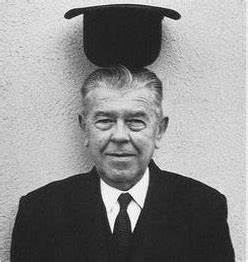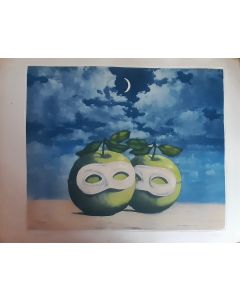René Magritte

René Magritte (1898 - 1967) was one of Belgium's greatest painters and one of the greatest exponents of Surrealism. He is known by the nickname "le saboteur tranquille" (quiet saboteurs) for his ability to insinuate doubts in the real world, representing apparently realistic subjects that amaze for mysterious details that give the work and the object itself a new and unusual meaning.
Despite his apparently playful approach to reality, Magritte's life is overshadowed by a terrible drama. His mother commits suicide by drowning herself in the Sambre River when René is only fourteen years old. The woman was found with her nightgown wrapped over her head, an image that young Magritte will not easily forget, reproducing it in some of his most famous works, his kisses with heads wrapped in white sheets are cleary.
The first years of his life are very quiet, he graduated from the Academy of Fine Arts in Brussels, he married Georgette Berger and worked as a graphic designer.
His life changes after having seen on a magazine the work Canto d'Amore by Giorgio de Chirico. This is how Magritte decides to dedicate himself to an art that represents ideas and not simply "the aesthetics of reality". In 1925 he created his first surrealist work: Le Jockey perdu (The Lost Jockey).
In 1926, thanks to Breton, theorist and leader of the surrealist movement, Magritte held his first solo exhibition, but the exhibition was not a critical success. This event led him to move to Paris with his wife. Even there things are not going well because the gallery that had put him under contract suddenly closes and he has to return to Bruxellls where he continues to work as a graphic designer.
His artistic style changed abruptly in the forties, with the Nazi domination. To escape Magritte and his wife move to the south of France, in Carcassone. In these years the artist realized raw, ironic and naive works, so much so that this artistic phase of his is remembered as "periodo vache" that means "The cow period", probably for the very grotesque way he had of representing faces. Also in this case the critics did not appreciate.
The consecration will arrive in the Sixties thanks to an important exhibition at the Museum of Modern Art in New York only a few years before his death.
Magritte's name became famous after the sixties, with the advent of pop culture. Cinema, music and comics have often referred to the Belgian artist's works: the Jeff Beck Group chose the work "La salle d'écoute"(1954) for the cover of the Beck-Ola album, while the cover of issue 41 of the comic strip Dylan Dog, entitled Golconda, is clearly inspired by the painter's work of the same name, made in 1953.
It can be said that unlike the great names in the history of contemporary art Magritte had a common life, which however had an unusual ability to transform everyday life into a surreal dream. Giving us the possibility to look at the most banal objects with different eyes.
"Reality is never as we see it: the truth is above all imagination". (René Magritte)


